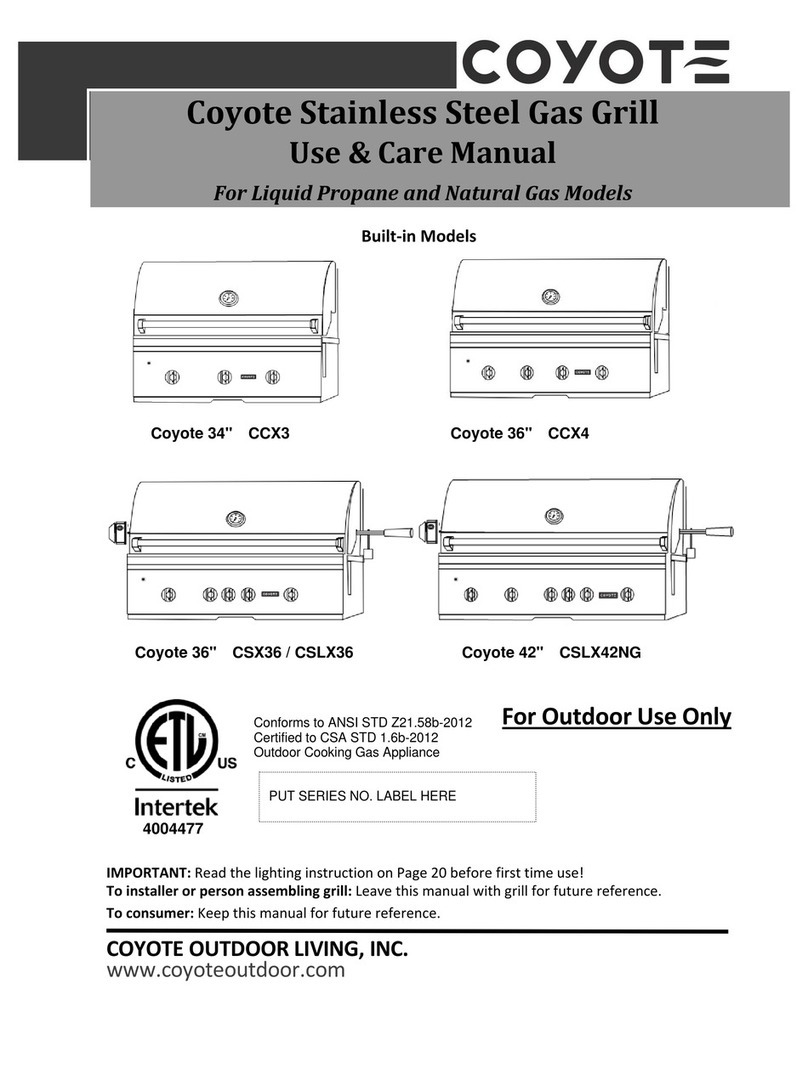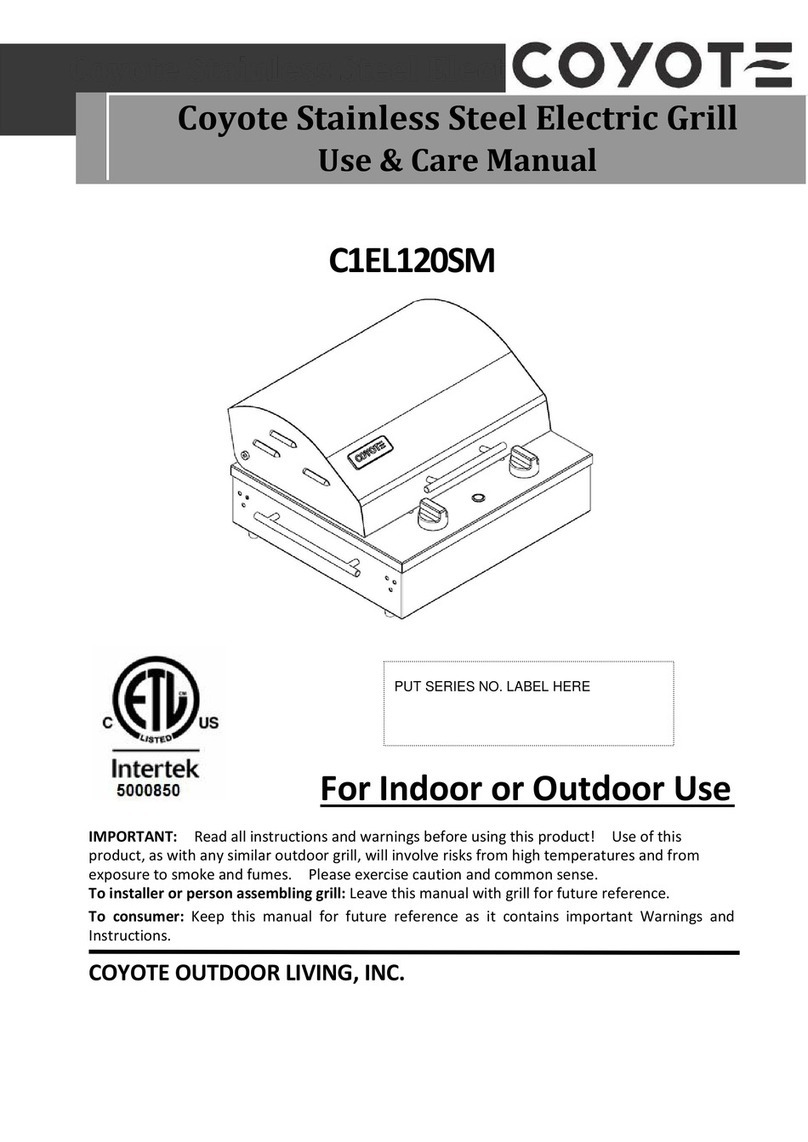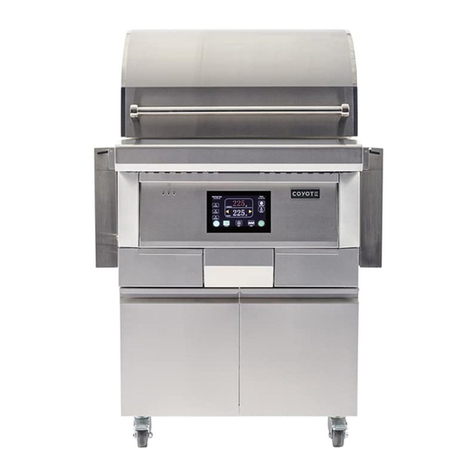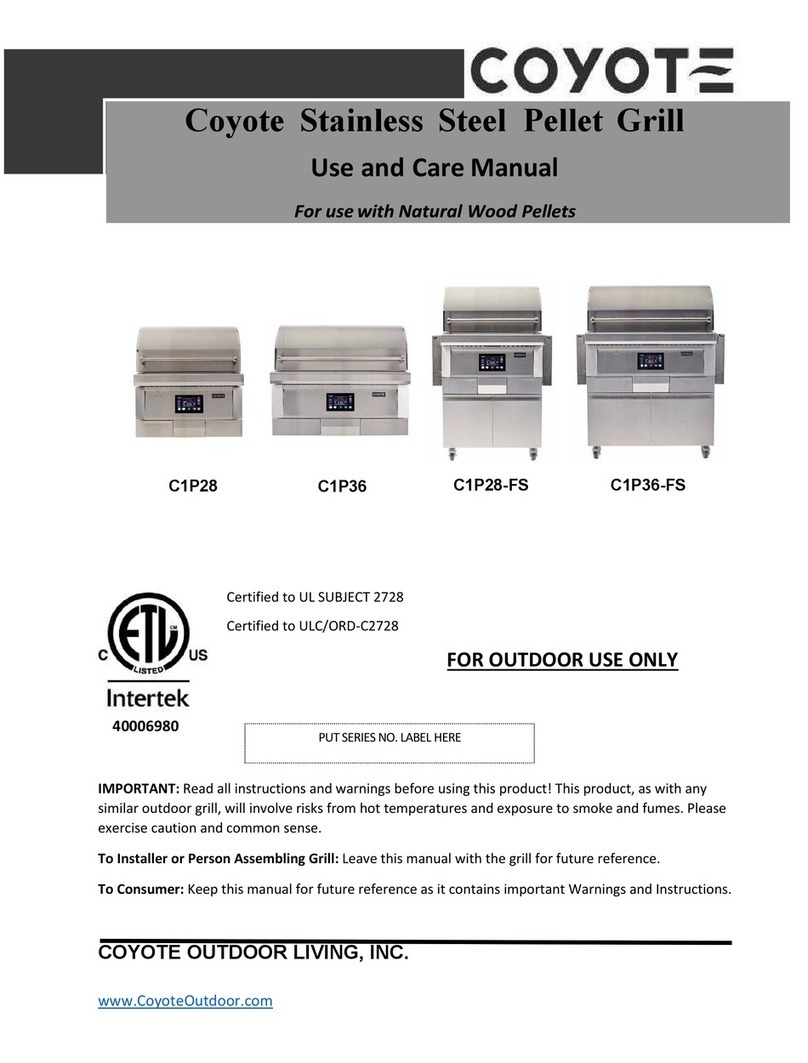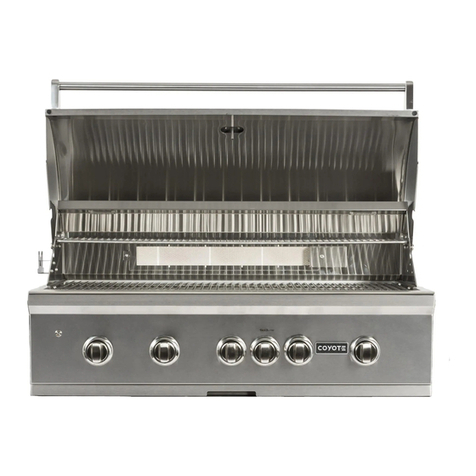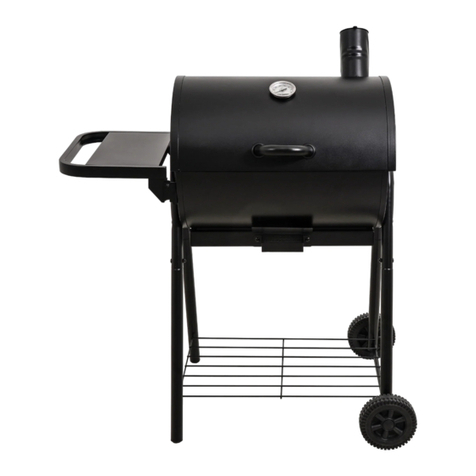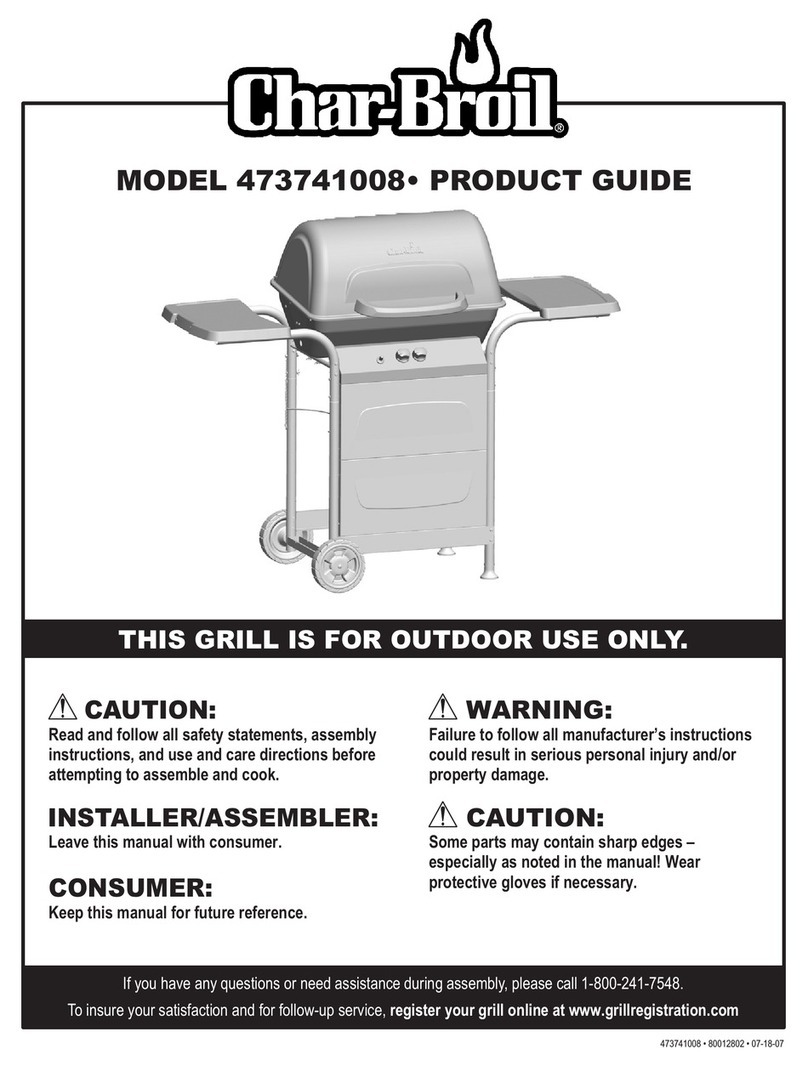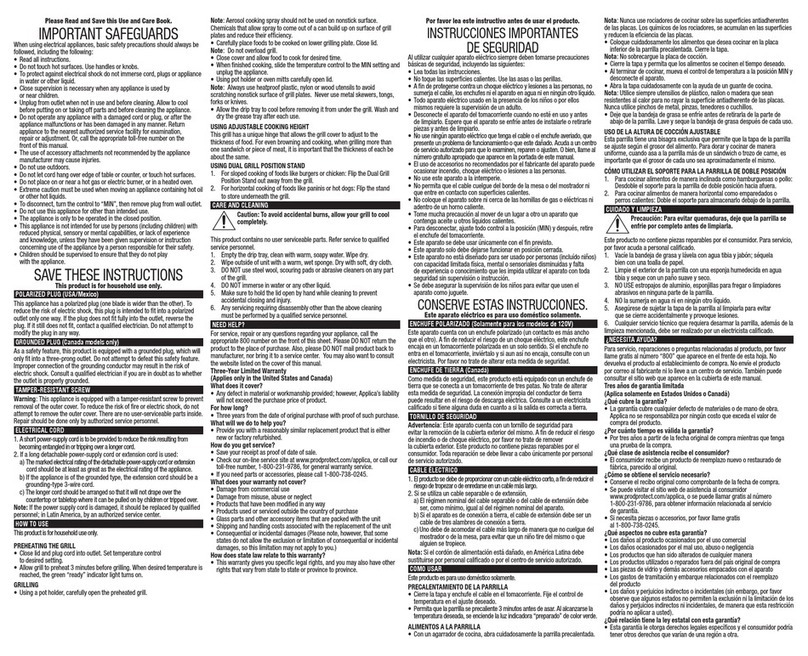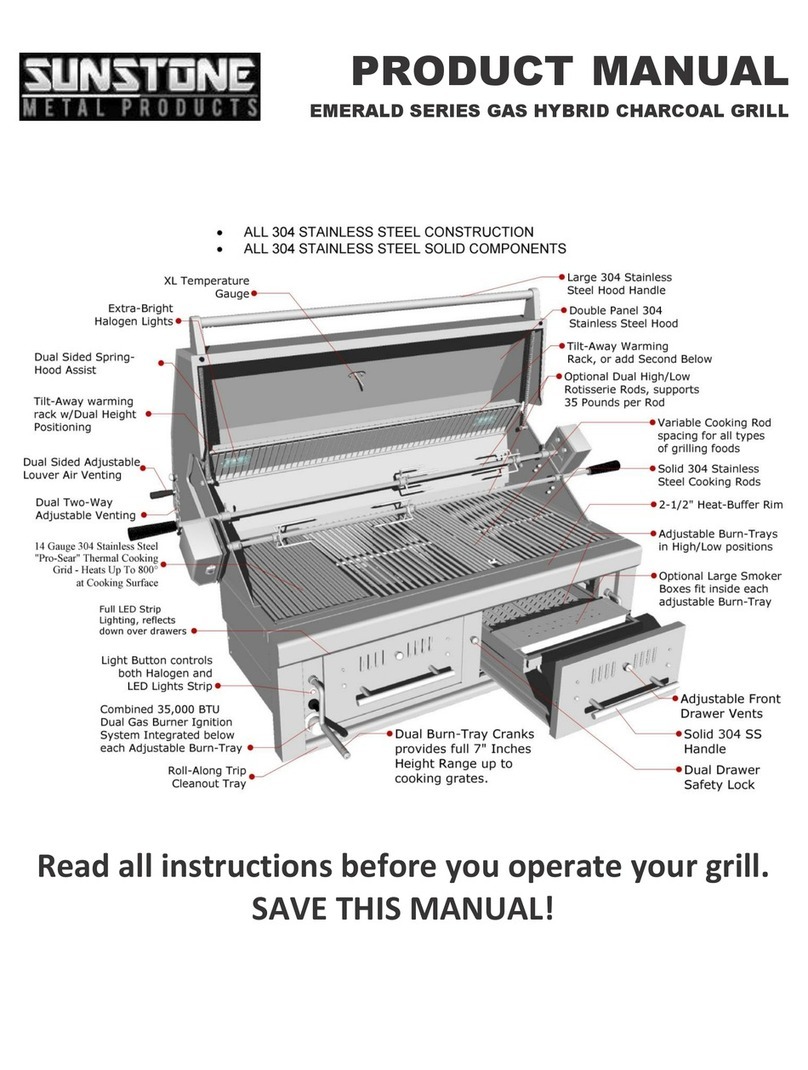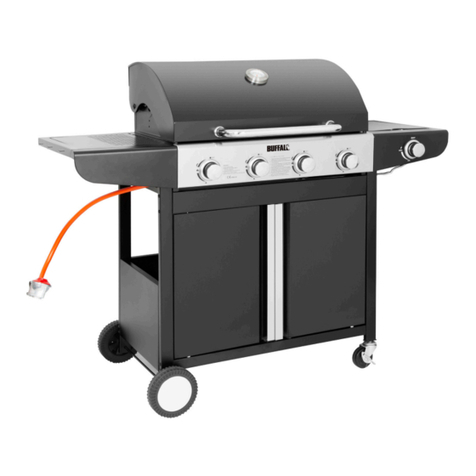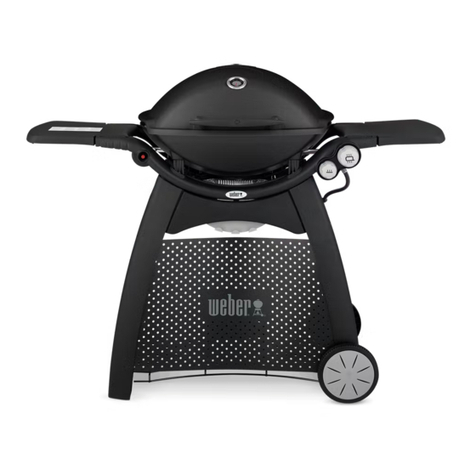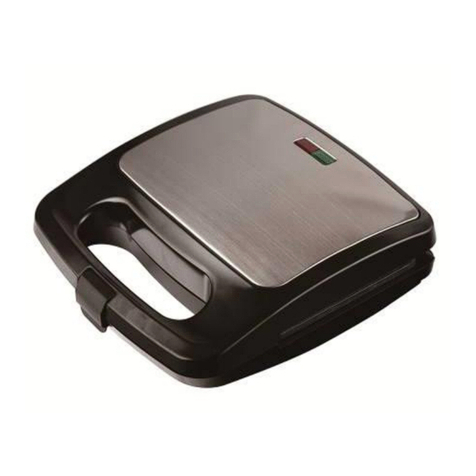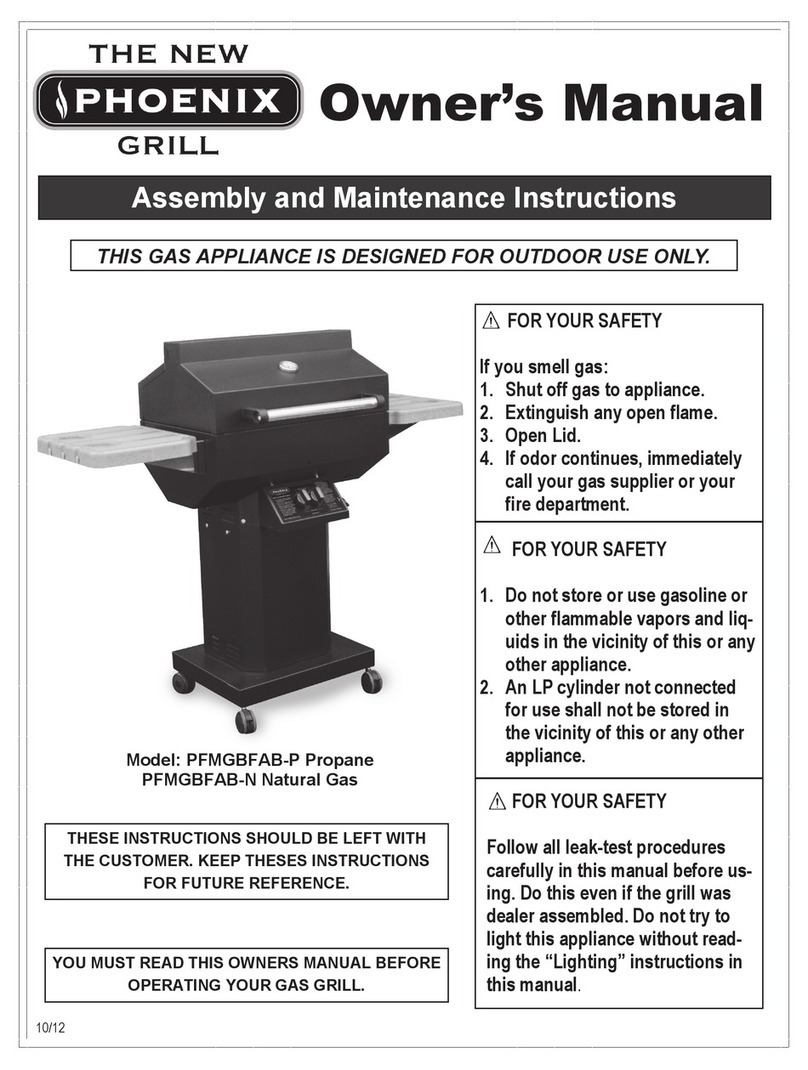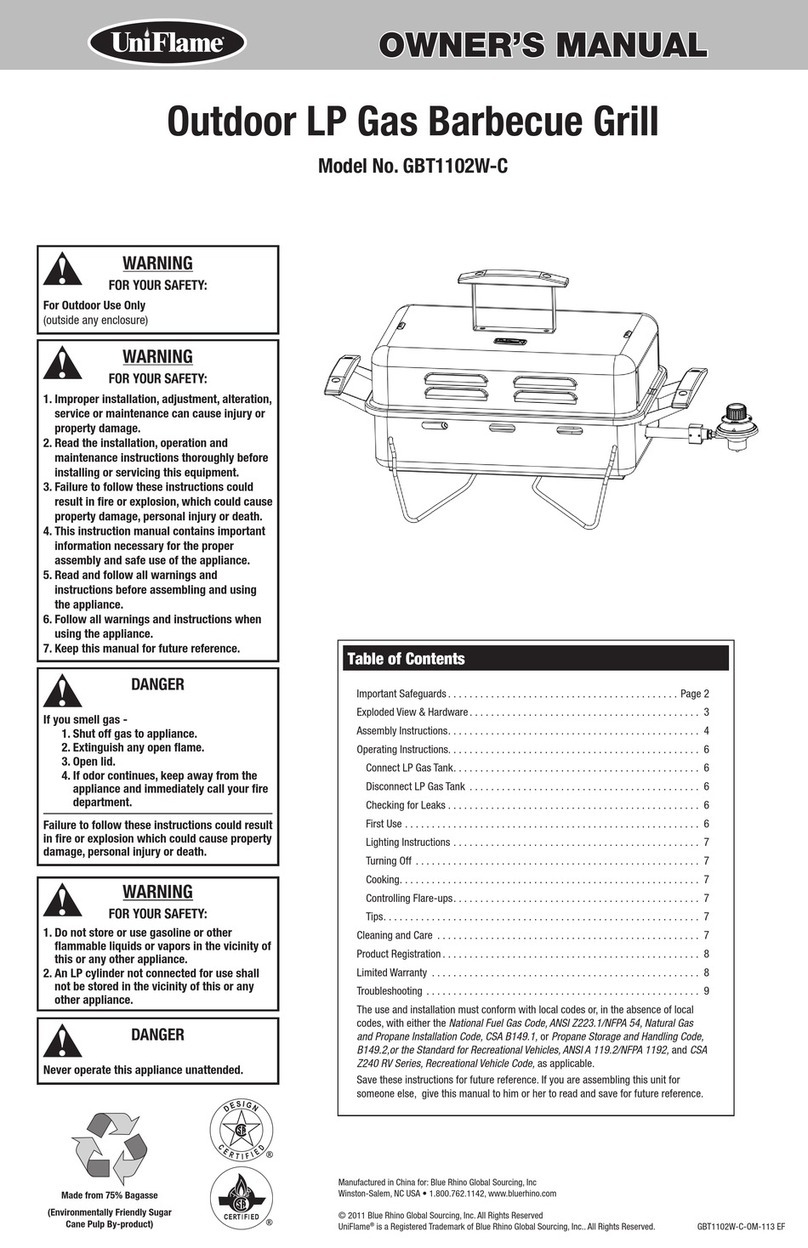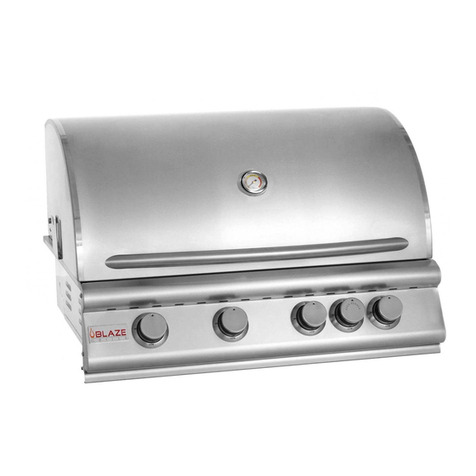Coyote CC2LP User manual

Built-in Models
For Outdoor Use Only
IMPORTANT: Read the lighting instruction on Page 18 before first time use!
To installer or person assembling grill: Leave this manual with grill for future reference.
To consumer: Keep this manual for future reference.
COYOTE OUTDOOR LIVING, INC.
www.coyoteoutdoor.com
Coyote Stainless Steel Gas Grill
Use & Care Manual
For Liquid Propane and Natural Gas Models
Coyote 2-Burner Grill (CC2LP/CC2NG) Coyote 3-Burner Grill (CC3LP/CC3NG)
Coyote 36"Grill (CS36LP/CS36NG) Coyote 42" Grill (CS42LP/CS42NG)
Coyote 36" Grill (CSL36LP/CSL36NG) Coyote 42" Grill (CSL42LP/CSL42NG)
Conforms to ANSI
STD Z21.58a-2008
Certificated to CSA
STD 1.6a-2008
4004477
PUT SERIES NO. LABEL HERE

Welcome & Congratulations
Congratulations on your purchase of a new grill! We are very proud of our product and we
are completely committed to providing you with the best service possible. Your satisfaction
is our #1 priority.
Please read this manual carefully to understand all the instructions about how to install,
operate and maintain for optimum performance and longevity.
We know you’ll enjoy your new grill and thank you for choosing our product. We hope you
consider us for future purchases.
Please read and save the instructions
This Manual provides specific operating instructions for your model. Use your grill only as
instructed in this manual. These instructions are not meant to cover every possible
condition and situation that may occur. Common sense and caution must be practiced
when installing, operating and maintaining any appliance.

1
Table of Contents
Safety Instructions…..................... 2
Grill Models..................................4
Locating the Grill .........................5
Gas Requirements ......................7
Using Your Burners & Grilling……13
Lighting Your Grill…………………18
Operation and Features………….20
Care & Maintenance……………...21
Troubleshooting Your Grill………26
Limited Warranty……………….…28
Parts Listings……………………..30
Safety Symbols
•WARNING
IF YOU SMELL GAS:
1. Shut off gas to the appliance.
2. Extinguish any open flame.
3. Open Lid.
4. If odor continues, keep away from the
appliance and immediately call your gas
supplier or your fire department.
•WARNING
WARNING:
1. DO NOT store or use gasoline or other
flammable liquids or vapors in the vicinity of
this or any other appliance.
2. An LP cylinder not connected for use shall
not be stored in the vicinity of this or any
other appliance.
•WARNING
DANGER indicates an imminently
hazardous situation which, if not
avoided, will result in death or serious
injury.
•CAUTION
CAUTION indicates a potentially
hazardous situation which, if not
avoided, may result in minor or
moderate personal injury, or property
damage.
•WARNING
FOR OUTDOOR USE ONLY:
NEVER operate grill in enclosed areas, as
this could lead to gas accumulating from a
leak, causing an explosion or a carbon
monoxide buildup which could result in injury
or death. DO NOT use your grill in garages,
breezeways, sheds or any enclosed area.
NOT FOR USE BY CHILDREN. If these
instructions are ignored, a hazardous fire or
explosion could result in physical injury,
death or property damage!
•WARNING
WARNING indicates a potentially
hazardous situation which, if not
avoided, could result in death or
serious injury.

2
WARNING:
Improper installation, adjustment, alteration, service or maintenance can cause injury
or property damage. Read the installation, operating and maintenance instructions thoroughly
before installing or servicing this equipment.
General Safety Instructions
1. For Household Outdoor Use Only – DO NOT use indoors or in any type of enclosed area such as a
garage, shed or breezeway. Keep clear of trees and shrubs. The grills are not intended for
installation in or on recreational vehicles, portable trailers, boats or any other moving installation.
Not for commercial use.
2. The area surrounding your new grill should be kept clean and free from flammable liquids and
other combustible materials such as mops, rags or brooms, as well as solvents, cleaning fluids,
and gasoline.
3. To reduce the risk of serious or fatal injury from breathing toxic fumes and from explosion and fire
as a result of leaking gas, use only outdoors in an open area with good ventilation. Do not obstruct
the flow of combustion and ventilation air.
4. Never use the grill in windy conditions. If located in a consistently windy area (oceanfront,
mountaintop, etc.) a wind break will be required. Always adhere to the specified clearances listed.
5. Do not leave the grill unattended while cooking.
6. Do not use natural gas in a unit designed for liquid propane gas or vice versa.
7. Do not use fuel such as charcoal briquettes in a gas grill.
8. Keep children and pets away from hot grill. DO NOT allow children to use or play near the grill.
9. Never attempt to repair or replace any part of the grill yourself unless specifically recommended in
this manual. All other services should be performed by a qualified service technician.
10. Never lean over an open grill. Do not place clothing or other flammable material on or near the grill.
Do not wear loose-fitting clothes or long sleeves while using the grill as some fabrics can be highly
flammable.
11. Have an ABC fire extinguisher accessible. Never attempt to extinguish a grease fire with water or
other liquids.
12. Never use aluminum foil to line the grill racks or the drip trays, this can alter airflow for proper
combustion and also build up heat in the control area causing the knobs and igniter to melt.
13. When using the grill, do not touch the grill rack, burner grate, or immediate surroundings as these
areas become extremely hot and can cause burns. Always use a covered hand when opening the
grill hood and only do so slowly to allow heat and steam to escape.
14. DO NOT allow grease or other hot material dripping from the grill onto valve, hose or regulator,
turn off gas supply immediately. After the grill has cooled, determine the cause and correct it. After
cleaning the valve, hose and regulator, perform a leak test before continuing use.
15. Do not heat any unopened glass or metal container of food on the grill. Pressure may build up and
cause the container to burst, possibly resulting in serious personal injury or damage to the grill.
16. Keep any electrical supply cords away from water or heated surfaces. Electrical cords should be
placed away from walkways to avoid tripping hazard.
17. Keep gas supply lines as short as possible.
18. Never move the grill when hot.
Safety Instructions

3
19. DO NOT use while under the influence of drugs or alcohol.
20. DO NOT store a spare gas cylinder under or near your grill.
21. DO NOT grill without the drip tray in place, hot grease could leak downward and produce a fire or
an explosion. Drip tray should be pushed all the way to the rack located just under the grill.
22. Grease is extremely flammable. Let hot grease cool down before attempting to handle or dispose
of it. The drip tray should be cleaned and free of grease on a regular basis.
23. In the event that a burner goes out, turn burner knobs to the full OFF position, fully open the grill
hood and let it air out. Do not attempt to use the grill until the gas has had time to dissipate.
24. Do not use grill until leak check has been made.
25. Turn off the cylinder valve when your grill is not in use.
26. Ensure the control knobs are in the “OFF” position when not in use.
27. Use only a Ground Fault Interrupter (GFI) protected circuit with this outdoor cooking gas appliance.
CALIFORNIA PROPOSITION 65 - WARNING: The burning of gas cooking fuels generates some
byproducts which are on the list of substances which are known by the State of California to cause
cancer or reproductive harm. California law requires businesses to warn customers of potential
exposure to such substances. To minimize exposure to these substances, always operate this unit
according to the Use and Care Manual, ensuring you provide good ventilation when cooking with gas.

4
Whether you are in need of a slimmer 2 Burner grill for your patio, or are in need of a larger 42” grill,
that can entertain and bring style to any size party, Coyote has the grill for you!
Model No.
Product Size
(inch/mm)
BTU/HR
(Main/Back)
Burner(s) Rotisserie
Motor
Hood
Light
CC2LP / CC2NG 28 (711.2) 20,000/None 2 SUS burners No No
CC3LP / CC3NG 34 (863.6) 60,000/None 3 SUS burners No Yes
CS36LP/CS36NG
CSL36LP/CSL36NG
35½ (902) 80,000/15,000 3 SUS burners, 1 sear
and 1 back burner
Yes Yes
CS42LP/CS42NG
CSL42LP/CSL42NG
42(106.7) 100,000/15,000 4 SUS burners, 1 sear
and 1 back burner
Yes Yes
Grill Models
Coyote 2-Burner Grill (CC2LP/CC2NG) Coyote 3-Burner Grill (CC3LP/CC3NG)
Coyote 36” Grill (CS36LP/CS36-NG) Coyote 42” Grill (CS42LP/CS42NG)
Coyote 36" Grill (CSL36LP/CSL36NG) Coyote 42" Grill (CSL42LP/CSL42NG)

5
Check your local building codes for the proper method of installation. In the absence of local codes, this
unit should be installed in accordance with the National Fuel Gas Code No. Z223.1-1998 USA or
CAN/CGA-B149.1/.2 Natural Gas/Propane Code (Canada) latest edition or the National Electrical
Code ANSI/NFPA No. 70 or the Canadian Electrical Code CSA C22.1, 1990 or latest version.
- Before installing built-in grills in enclosures, copy all product information such as model number,
serial number and type of grill (e.g. natural gas or LP) and store information in a safe place.
- If the grill is installed by a professional installer or technician, be sure that he shows you where
your gas supply shut-off is located. All gas lines must have a shut-off that is readily and easily
accessible. If you smell gas, check for gas leaks immediately. Check only with a soap and water
solution. Never check for gas leaks with an open flame.
Notice:
We strongly recommend professional installation and hookup of the Gas BBQ grill. These
instructions will provide you with the measurements necessary for you or your builder to construct a
masonry structure to house your outdoor gas grill.
IMPORTANT:
Gas fittings, regulator, and installer supplied shut-off valves must be easily accessible.
LOCATION OF YOUR GRILL:
Locate the grill only in a well ventilated area. Never locate the grill in a building, garage, breezeway,
shed or other such enclosed areas without an approved ventilation system. During heavy use, the grill
will produce a lot of smoke. Ensure there is adequate area for it to dissipate.
Ventilation Requirements for Proper Operation of your Coyote Grill
•Ventilation for a gas grill is absolutely mandatory to ensure that your grill performs as intended and
to ensure the safety of you and your family. The vents that are required to honor a Coyote warranty,
not only ensure that any heat that is trapped inside your grill from environmental factors (such as
wind) escape but they also allow any gas that has leaked from a tank or connection, to escape
before a buildup of such gas can occur and possibly ignite.
•A simple way to think of what is occurring inside your grill is that when your burners are on, they are
emitting a flame that creates the heat to cook your food. This heat must exhaust from the grill,
otherwise you would eventually have a unit that would not only build up immense heat but also
immense pressure. This could cause severe damage to not only the grill but any operators or
property near by. With that said, if you have wind coming into the back of your unit, the problem will
not be with the wind hitting your flames and causing them to push the flame downward. The problem
actually lies with the wind acting as a block for the exhaust, which is mainly out the back of the hood
(above the rear panel but below the top of the hood). This blockage of exhaust is what starts the
problems.
•If the island is ventilated properly (with a minimum of 2 vents for cross ventilation and at least 20 sq
in on each vent) then any heat that is trapped inside due to wind should be able to dissipate out of
the island vents. However, if the island is not ventilated properly and the wind is coming from the
back, then the heat will try to escape through the easiest exit, which will most likely be through the
bottom of the grill and front control panel. This can cause the control panel and knobs to get hot to
the touch and possibly even burn your fingers, not to mention that it can melt all rubber gaskets on
Locating the Grill

6
the valves and damage the ignition system to where it will need full replacement.
•Ventilation and the variable of your most common wind direction must always be considered when
planning your outdoor cooking island. Just the same as you would plan the layout and measure your
indoor kitchen, you must also do the same for the outdoors but you can not forget about Mother
Nature and the effects she can have on your outdoor cooking equipment.
oCoyote Wind Guards: If you do run into a situation where you will have wind coming into
the back of the unit, Coyote does sell "Wind Guards" that help keep your grilll from
overheating due to no exhaust occuring out the back of the grill. Our Wind Guards should
never be considered as a guaranteed solution to this problem. They are only intended to
help the wind divert up and over the top of the grill. If the wind is strong, then you can still
have problems with the heat being trapped in the hood. Our Wind Guards can be purchased
through any of our authorized dealers.
Clearance
:
•TO NON-COMBUSTIBLE CONSTRUCTION: For non-combustible material, Coyote grills can
be placed directly on, or adjacent to the non-combustible material. The hood on a Coyote grill
pivots mainly on the body. If you have a wall or partition behind the unit that would block
ventilation, then a minimum of 7" clearance from the back of the grill to the wall is needed for
the purpose of ventilation. If you do not have a wall or partition blocking the ventilation of the
unit, then you only need an extra 2" behind the unit for the hood to open fully. If you wish to use
the rotisserie option, you will want to make sure that you leave adequate space (at least 6") on
each side of the grill so that the motor and rotisserie spit handle will have room on the counter,
as these extend past the overall dimensions of the grill body.
•CLEARANCE TO COMBUSTIBLE CONSTRUCTION: For combustible construction, you must
have at least 24" clearance to any combustible material (in any direction) for a Coyote Warranty
to be upheld and for the safety of the homeowner. You can NOT locate the grill under any
combustible material without an approved ventilation system directly located above the unit.
•
INSULATED JACKETS AND COMBUSTIBLE CONSTRUCTION:
If you must use combustible
material to build your grill island AND you are going to be within 24" of the grill with this
combustible material, then you must use the appropriate Coyote Insulated Jacket. The
insulated jacket will act as a barrier to protect your grill island from the heat and fire of your
Coyote grill. If an insulated jacket is not used in a combustible material island, the warranty on
the Coyote grill will be voided immediately and safety can not be ensured.
For Built-in Installations
A built-in grill is designed for easy installation into masonry enclosures. For non-combustible
applications, the grill drops into the opening (as shown in cut-out detail drawing - Fig. A) and hangs
from the grill body itself. A bottom deck is not required to support the grill from the bottom. It is also
required that:
•Two ventilation holes, of at least 20 sq inches in size, must be present to help release any gas
from a leak.
As Propane is heavier than air, locate your vents at the tank valve height or lower
•The counter should be flat and level in reference to the floor.
LP TANK STORAGE MUST BE ISOLATED IN A SEPARATE COMPARTMENT FROM THAT OF THE
GRILL AND IT MUST BE VENTED AS WELL. (RECOMMEND BOTTOM VENTS FOR LP)

7
Cut out Dimensions Figure A
IMPORTANT:
Before connecting grill to gas source, make sure BBQ Grill control knobs are in the
“OFF” position.
•Verify the type of gas supply to be used, either natural or LP, and make sure the marking on the
appliance rating label agrees with that of the supply.
WIDTH DEPTH HEIGHT
2 Burner 31” (787mm)
20 ½” (521mm) 11” (279mm)
3 Burner 32 ½” (825mm)
20 ½” (521mm) 11” (279mm)
4 Burner 39 ½” (1003mm)
20 ½” (521mm) 11” (279mm)
5 Burner 25” (635MM) 20 ½” (521mm) 11” (279mm)
WARNING:
Never attach an unregulated gas line to the appliance. Connection to an
unregulated gas line can cause excessive heat or fire.
NOTE: Always have a qualified service technician perform difficult conversions
or modifications.
Gas Requirements

8
•All pipe sealants must be an approved type and resistant to the actions of LP gas. Never use
pipe sealant on flare fittings.
•The installation of this appliance must conform with local codes or, in the absence of local
codes, with either National Fuel Gas Code, ANSI Z223.1/ NFPA 54, Natural Gas and Propane
Installation Code, CSA B149.1, or Propane Storage and Handling Code, B149.2, or the
Standard for Recreational Vehicles, ANSI A 119.2/ NFPA 1192M, and CSA Z240 RV Series,
Recreational Vehicle Code, as applicable.
WARNING:
Gas valves are preset at the factory to operate on LP or natural gas. If you wish to
convert, be sure to contact your grill dealer FIRST!
This propane gas grill is designed to operate on propane gas ONLY, at a pressure regulated at 11”
(279.4mm) water column (W.C.) when equipped with the correct propane orifices on the valves and a
propane regulator on the supply line regulated at the residential meter. The LP gas grill is designed to
be used with a standard 20 lbs gas cylinder and must be constructed and marked in accordance with
specifications of the US Department of Transportation for propane gas cylinders.
Always keep cylinder securely fastened in an upright position. Never connect an unregulated propane
gas cylinder to the grill.
Do not subject propane cylinders to excessive heat.
CAUTION:
Never store a LP gas cylinder inside a building or in the vicinity of any gas-burning
appliance.
Cylinder Specifications
- Any L.P. gas supply cylinder used with this grill must be approximately 12 inches diameter and 18
inches high. The maximum fuel capacity is 80% and is approximately
20 pounds of propane.
- The L.P. cylinder must have a shut-off valve (see picture) terminating
in a Type 1 L.P.
- A Type 1 compatible cylinder with a Type 1 cylinder valve has a
back-check valve which does not permit gas flow, until a positive seal
has been obtained.
- The cylinder must be arranged for vapor withdrawal. It must also
include a collar to protect the cylinder valve. A safety relief device
having direct communication with the vapor space of cylinder must be
provided. This will expel high pressure gas if the cylinder is overfilled
or overheated which could result in fire or explosion.
- All L.P. gas cylinders used with this appliance shall be constructed and marked in accordance with
the specifications for L.P. gas cylinders of the U. S. Department of Transportation (DOT) or the
National Standard of Canada, CAN/CSA-B339, Cylinders, Spheres and Tubes for Transportation
of Dangerous Goods; and Commission, as applicable; and shall be provided with a listed overfilling
LP Gas Hook-up

9
prevention device.
- Read labels on the L.P. Gas Supply Cylinder.
- New cylinders are always shipped empty for safety.
- Allow only qualified L.P. gas dealers to fill or repair your L.P. gas supply cylinder.
- Inform the gas dealer if it is a new or used cylinder to be filled.
- After filling, have the gas dealer check for leaks and to see that the relief valve remains free to
function.
Hose and Regulator (Comes standard with the grill)
The Type 1 connection system has the following features:
- The system will not allow gas to flow until a positive connection
has been made.
NOTE: The cylinder control valve must be turned off before
any connection is made or removed.
- The system has a thermal element that will shut off the flow of gas
in the event of a fire.
- The system has a flow limiting device which, when activated, will
limit the flow of gas to 10 cubic feet per hour.
- NEVER use grill without leak testing this connection.
LP (Propane) Gas Supply Connection
1. The tank valve should be in the “OFF” position. If not, turn the knob
clockwise until it stops.
2. Make sure all burner valves are in the “OFF” position.
3. Always connect the gas supply regulator as follows:
Insert the regulator inlet into the tank valve and turn the coupling nut
clockwise until the coupler tightens up (see picture). Do not over
tighten the coupler. Turn the main tank valve on and turn the burner
control valves on the unit to the “HIGH” position for about 20 seconds
to allow the air in the system to purge before attempting to light the burners.
Pre-Operation Leak Testing
DANGER
1. Do not insert any tool into the valve outlet or safety relief valve. You may damage the valve and
cause a leak. Leaking propane may result in explosion, fire, severe personal injury, or death.
2. If a leak is detected at any time or you cannot stop a gas leak, immediately close pipeline valve
and call LP gas supplier or you fire department!
3. Check all gas supply fittings before each use and each time the gas supply cylinder is connected
to the regulator. Have a qualified service technician leak test the grill any time a part of the gas
system is replaced.
WARNING
Never attempt to attach this grill to the self-contained LP gas system. Do not use grill until leak testing.

10
Before Testing
DO NOT smoke while leak testing. Extinguish all open flames. Never leak test with an open flame. Mix
a solution of equal parts mild detergent or liquid soap and water.
Leak Testing Valves, Hose and Regulator
1. Turn all grill control knobs to OFF.
2. Be sure hose is tightly connected to LP tank.
3. Completely open LP tank valve by turning cylinder
valve knob counterclockwise (right to left). If you hear
a rushing sound, turn gas off immediately. There is a
major leak at the connection. Correct before
proceeding by calling franchiser for replacement
parts.
4. Brush soapy solution onto areas where bubbles
are shown in LP tank (see picture).
5. If “growing” bubbles appear, there is a leak. Close
LP tank valve immediately and retighten connections.
If leads cannot be stopped do not try to repair. Call franchiser for replacement.
6. Always close LP tank valve after performing leak test by turning cylinder valve knob clockwise.
NOTE:
When leak testing this appliance, make sure to test and tighten all loose connections, including
the side burner. A slight leak in the system can result in a low flame, or a hazardous condition.
LP Gas Supply Cylinder Disconnection
1. Turn the burner valves off.
2. Turn the tank valve off. (Turn clockwise to stop).
3. Detach the regulator assembly from the tank valve by turning the quick coupling nut
counterclockwise.
LP Tank Removal, Transport and Storage
- Turn OFF all control knobs and LP tank valve. Turn coupling nut counterclockwise by hand only -
do not use tools to disconnect. Lift LP tank wire upward off of LP tank collar, then lift LP tank up
and off of support bracket. Install safety cap onto LP tank valve. Always use cap and strap
supplied with valve. Failure to use safety cap as directed may result in serious personal injury
and/or property damage.
- A disconnected LP tank in storage or being transported must
have a safety cap installed
(as shown). Do not store an LP tank in enclosed spaces such
as a carport, garage, porch, covered patio or other building.
Never leave a LP tank inside a vehicle which may become
overheated by the sun.
- Do not store LP tank in an area where children play.

11
LP Tank Filling
- Use only licensed and experienced dealers.
- LP dealer must purged tank before filling.
- Dealer should NEVER fill LP tank more than 80% of LP tank volume. Volume of propane in tank
will vary by temperature.
- A frosty regulator indicates gas overfill. Immediately close LP tank valve and call local LP gas
dealer for assistance.
- Do not release liquid propane (LP) gas into the atmosphere. This is a hazardous practice.
- To remove gas from LP tank, contact an LP dealer or call a local fire department for assistance.
Check the telephone directory under “Gas companies” for nearest certified LP dealers.
LP Tank Exchange
- Exchange your Type 1 cylinder with OPD safety feature-equipped ONLY.
- Always keep new and exchanged LP tanks in upright position during use, transit or storage. Leak
test new and exchanged LP tanks BEFORE connecting to grill.
Large Capacity Propane Tanks and Homes:
•LP (Liquid Propane) Coyote Grills can be installed into propane fueled houses. Meaning that if
your entire house is plumbed for propane and you have an exterior connection for such use,
then a standard LP grill from Coyote will meet your needs, regardless of the size. Any appliance
can be installed if installed properly! That is the Coyote way!
oCoyote does not supply any gas fittings or lines, other than the regulator needed within
the grill box
oAll Coyote LP Grills come with a 20lb tank regulator. This regulator can not be used or
modified to work on any other setup.
If you are running off of a large capacity tank (more than 20lbs), then an “in-line”
LP regulator is needed, Coyote Customer Service must be contacted to assist
with this situation.
oAs counties vary from state to state, it is upon the owner/installer to ensure that all
county, state and federal codes are followed for any gas installation.
-
Always check the rating plate to make sure the gas supply you are hooking up to is the gas type the grill
is manufactured for.
This natural gas grill is designed to operate on natural gas ONLY, at a pressure regulated at 4”
(101.6mm) water column (W.C.) when equipped with the correct natural gas orifices on the valves and
a natural gas regulator on the supply line regulated at the residential meter.
IMPORTANT: Never connect the grill to an unregulated gas supply.
Natural gas connections must be performed by a licensed contractor or local gas company
representative.
Natural Gas Hook-up

12
Natural Gas Hose and Regulator
IMPORTANT: NEVER use grill without leak testing this connection.
Natural gas regulator model: GR120
Gas pressure: 4” (101.6mm)
Maximum rate working pressure: 1/2 Psig
Natural Gas Supply and Connection
1. Make sure all burner valves are in the “OFF” position
2. All NG units need to have a regulator and shut-off valve on the supply line.
3. All Pipe threads need to have proper, gas rated, outdoor rated thread sealant. Flare ends do not
need or utilize pipe sealant.
4. Your NG Coyote grill comes with a ½” regulator, along with a 18” black hose.
a) You need to seal the regulator to the hose using your pipe sealant.
b) Then attach the flare end to your manifold line, with no pipe sealant.
c) Next, attach your next connection hose (not included) to the other side of the NG regulator (it
is also ½” MIP)
i. We suggest using ½” stainless steel corrugated hoses for all NG Grills
ii. Make sure that you purchase a hose of adequate length and capacity for the intended
application.
d) Connect the other end of this hose, to your shut off valve
i. Depending on your choice of hose and shut-off, the nipple going into the shut-off valve
may vary.
e) Test all connections for leaks with a soap and water solution.
High Elevation Installation and Use
Coyote Grills are designed to operate most efficiently at 0-2000 feet above sea level. From 2000-4000 feet
above sea level you will not notice any substantial decrease in your heat, although more gas is combusting
within the burners due to less oxygen. Above 4000 feet, you may experience a little longer cooking time on
your grill than you would experience at sea level. But again, this is just due to the air/fuel mixture taking
place within the burners. If any problems or concerns exist about your location or elevation, please contact
Coyote Customer Service for assistance.
Gas Conversions – Natural Gas and Propane
Coyote grills are able to be converted but you must obtain the correct conversion kit and we alwayrs
recommend that any gas appliance conversion should always be performed by a Licensed Plumber or a
certified Installer. Conversion kits are sold for Coyote grills and can be purchased through your dealer, or

13
Coyote’s Customer Service Department. Any other kit or orifices used that are not of Coyote brand, will
automatically void any warranty on the unit. Furthermore, it is important to understand that where ever there
is a burner, there is an orifice that will need to be changed (do not forget the rotisserie or sear burner).
The steps for converting your Coyote grills main and sear burners are:
1. Pull grill out of island or cart.
2. Remove Drip Pan and Cooking Grates
3. Unscrew bolt connecting the manifold pipe to the grill body, located at the back side of the grill.
4. Unscrew the 4 bolts holding the faceplate to the body (on the front edge where your cooking grate
sits)
5. Unscrew the 2 bolts (on each side) of the manifold and faceplate assembly, that holds this entire
assembly to the body of the grill.
6. Disconnect all wires and flex lines, from the valves and igniter assembly while paying close
attention to their original location.
7. Slide entire control panel and valve assembly out from the grill body.
8. Flip control panel over on its side, so you have easy access to the valves.
9. Sear Burner Grills Only – Remove center knob, unscrew top and bottom screws only.
a. The safety valve that controls the thermocouple on your sear burner must be completely
changed. You cannot change only the orifice.
10. Sear Burner Grills Only – Unscrew base bracket, hold center valve to gas manifold pipe and
remove valve
11. Sear Burner Grills Only – Install new Safety Valve in the correct gas type and follow the removal
instructions in reverse.
12. Once the panel is flipped over, you will see the orifice at the end of the valve. With a wrench remove
the orifice from the valve and install the new gas orifice,
13. Re-assemble in reverse and test all connections again with a soapy water solution to ensure no
leaks.
To convert your rear burner orifice:
1. Remove your entire rotisserie assembly
2. Remove the back panel that covers your rear rotisserie burner
a.With the hood open, remove the 4 screws on top of this panel
b.With the hood closed, remove the 4 screws on the back of this panel
c.With the hood closed, look underneath this same back panel and you will see 4-5 bolts
(depending on your grill), these only need to be loosened
3. Next, pull the entire panel (starting from the back) out from the grill
a.It is designed to fit tight, so you may need a flat head screwdriver to pop the stainless away
from the body
4. Next, you will see the gas line, brass elbow and orifice
5. Use a wrench to remove the orifice and install the new one
6. Re-assemble in reverse and check your back burner to ensure proper ignition and burning
Your grill is designed to reach a temperature that you set by adjusting a valve that in turns adjusts the
amount of gas that goes through each burner. This Valve is located behind your knob and is the key to your
Using Your Burners and Grilling Safely

14
heat and fuel consumption. An example being: Cooking on low will give you longer use out of a 20lb LP
tank than will cooking on high every single time.
Furthermore, the way to ignite the burners is through the valves, so please understand the importance of
this piece and the position/care taken to the knobs.
•Example: If you forget to turn a knob off and the burner is not lit, then you will have a gas leak out of
that valve. You must be aware of your grills status and be responsible!
Burner Configuration and Heat Dispersion:
If you look under the very front of your cooking grates, you will realize that for the first few inches, the burner
does not release any gas. This is designed to be the medium heat portion of your grill for several reasons.
•One being that the flavorizers ensure even heat dispersion laterally across your grills cooking
surface, so the front is designed to be your medium heat section, while you can utilize the middle of
your cooking grates to get a good high heat (do not forget that this all depends on how high you have
your valves turned as well).
•As you move towards the back of your grill and past the middle section, you will realize that this is the
hottest portion of your grill.
o
Underneath, where the burner is bolted to the back of the body, you will see that there is a
“crossover” in between each burner. This crossover, sends gas from one burner to the next
(as long as the valves are open), to ensure that all of your burners will light in case your
igniters fail.
o
For example, if you can only get one burner to light, you just need to keep the hood open and
turn on the valve next to it, to the high position. Gas will then travel through the new/open
burner and will catch the flame from the initial burner. This crossover does provide you
constant heat across the back that increases the temperature and provides you with your
hottest position on the grill (unless you have a CS model with a sear burner – in which the
sear burner will provide your highest temperature for cooking/searing).
To understand how this will effect your cooking, please take a look at the pictures below for visual assistance.
Burner Use – Indirect, Direct, Sear, Rotisserie Cooking
As you can imagine, by controlling how much gas flows through your burner; determines the size of your
flame. The ideal flame will be blue, with no yellow tip, or excessive noise coming out of the burner.
If you happen to have any of these problems:
•You will want to check the air adjustment screw on the side of the burner itself (called the Air

15
Venturi) and also the adjustment screw that resides directly below the orifice to ensure proper gas
flow into the burner from the valve
•There are many reasons that can cause poor flames and heat but none are more serious than a
gas leak, so always pay attention for the odor of gas (NG or LP) but do not also forget to clean your
burners!
For Direct Cooking you simply cook your food over a direct flame that is hot and quick to cook but is also
the quickest way to burn your food. Pay attention closely if you choose this method!
Indirect Cooking however is used for larger cuts of meats and anything that you are intending to keep nice
and juicy!
•All you need to do is turn off the burner that lies under the food being cooked and adjust the exterior
burners flame so that you create a slow, constant and even cooking environment for your food!
If you are looking for a cooking experience that will almost instantly cook your food item, then Sear
Cooking is an essential! Sear Cooking uses a ceramic burner that emits a different form of heat that can
produce a much higher temperature quicker, to lock in the juices!
Now, if you are looking for an experience that will allow you to have a juicy bird, straight from the rotisserie
of your grill, then Rotisserie Cooking is going to be your choice! Coyote grills utilize the same ceramic
burner technology in their sear burner, as their rotisserie burner, along with a motor and spit that will hold
and rotate up to 20lbs of food. Allowing you to cook a bird amazingly quick, without burning or charring any
portion of it
Instruction for Rotisserie Assembly
Rotisserie is mostly used to cook large pieces of meat and poultry to assure slow, even cooking. The
constant turning provides a self-basting action, making food cooked on a rotisserie exceptionally moist
and juicy. Rotisserie cooking generally requires 1 ½ to 4½ hrs to cook depending on the size and type
of meat being cooked. You can have rotisserie cooking with indirect heat with infrared rotisserie burner.
Preferred by professional chefs over other methods, the intense heat is ideal for searing in the natural
juices and nutrients found in quality meats.
For successful rotisserie, the meat should be centered and balanced as evenly as possible on the spit
rod to avoid overworking the rotisserie motor.
WARNING:
Never stand with your head directly over the Grill when preparing to light the Rotisserie
burner, to prevent possible bodily injury.

16
1. Attach Motor Bracket Assembly to the side of the barbecue frame (can be mounted on
either left or the right side of the frame) using two screws and two nuts.
2. Insert Rotisserie Motor onto Motor Bracket Assembly.
3. Assemble Key Washer, Counter-balance and handle to Spit Rod. Slide Shaft Collar with long end
towards handle.
4. Slide Prong Forks with the prongs facing away from the handle onto the Spit Rod. Place food on
to Spit Rod and secure with the second Prong Forks. Secure with thumbscrews. Place Spit Rod
assembly and position into Motor. Secure position with thumbscrew. It may be necessary to
secure any loose portions with butcher's string. Never use nylon or plastic string as it will melt
and ruin the food.
5. Once the food is secured, place the sharp end of the Spit Rod onto the motor, and then rest
the Spit Rod on the supports at either side of the grill.
6. Ensure that all Bolts are tightened securely.
7. When the rotisserie is being operated exclusively, it is strongly recommended that a pan be
placed on the grilling grids, beneath the food to catch the meat drippings. This will prevent
excessive build up of drippings on the grids and facilitate cleaning.
a) If your food is large and a pan will not fit on top of the grates, you can remove the cooking
grates and place your pan directly on the flavorizers.
i. The center of your spit rod to the top of the hood, equals the same distance from the
spit rod to the top of the flavorizers.
NOTE:
Close hood carefully and align Motor Bracket and Shaft Mounting Bracket so that Rotisserie
Rod is in between the hood openings.
No.
Qty
Description
1
1
110V Motor
No.
Qty
Description
1
1
110V Motor
2
1
Motor Bracket
3
1
Spit Rod
4
2
Shaft Collar
5
2
4
-
Prong Fork
6
1
Handle
7
1
Co
u
nterbalance
8
2
S
crew
9
2
H
exagonal
H
ead
S
crew
WARNING:
Never operate Rotisserie Burner with main (other) burner(s) “ON”. Warming Rack
must be removed when Rotisserie Burner is ON.
Electrical Grounding Instructions:
•The rotisserie motor is equipped with a three-prong grounding plug for your protection against
electric shock. This plug must be inserted directly into a properly grounded three-prong
receptacle. Do not cut or remove the grounding prong from this plug.
•The rotisserie motor must be electrically grounded in accordance with local codes or, in the
absence of local codes, in accordance with the National Electrical Code, ANSI/NFPA 70-1990
or Canadian Electrical Code, CSA C22.1.
•Do not use an extension cord to supply power to your grill. Such use may result in fire,
electrical shock or other personal injury. Do not install a fuse in the neutral or ground circuit. A
fuse in the neutral or ground circuit may result in an electrical shock hazard. Do not ground this
appliance to a gas supply pipe or hot water pipe.

17
Instruction for Connecting the Transformer
1. Transformer for Interior Lights - (only on CC3 and CS models)
Your transformer will connect on the left side of your grill (looking at it from the front) and operates the
lights inside your grill. Follow the pictures and insert the white male plug into the white female socket,
on the left side of your grill and then plug the transformer into a standard 110v outlet.
Left Side of Grills Male Plug Female Socket
2. Transformer for Back Lit Knobs – (only on CSL36 and CSL42 models with back lit knobs)
Your transformer will connect on the left side of your grill (looking at it from the front) and operates the
LED lights behind knob bezels. Follow the pictures and connect the transformer, and then plug the
transformer into a standard 110v outlet. Read below instruction for how to change new LEDs.
The Left Side of Grill Connect the Transformer
Remove the Knob Remove the Screws

18
Take Down the Knob Bezel The LED Plastic Bezel
Pull Out the Wires Disconnect the Wire and Change New LEDs
Do the opposite to assemble the LEDs.
WARNING: These two transformer should be kept away from the heat of the BBQ.
WARNING
•DO NOT use the grill if gas odor is present.
•DO NOT stand with head, body, or arms over the grill when lighting.
•Inspect the hose before using the grill. If there is excessive abrasion or wear, or if the hose is
cut, it must be replaced prior to the outdoor cooking gas appliance being put into operation.
The replacement hose assembly shall be that specified by the manufacturer.
•Ensure the area around the barbecue is clear of flammable substances such as gasoline, yard
debris, wood, etc.
•Ensure there is no blockage of the airflow through the vent space located below the face of the
unit.
DANGER
•Failure to open the lid while igniting the barbecue’s burners, or not waiting 5 minutes to allow
the gas to clear if the barbecue does not light, may result in an explosive flame-up which can
cause serious bodily injury or death.
Lighting the Grill
Other manuals for CC2LP
1
This manual suits for next models
15
Table of contents
Other Coyote Grill manuals

Coyote
Coyote C1EL120SM User manual
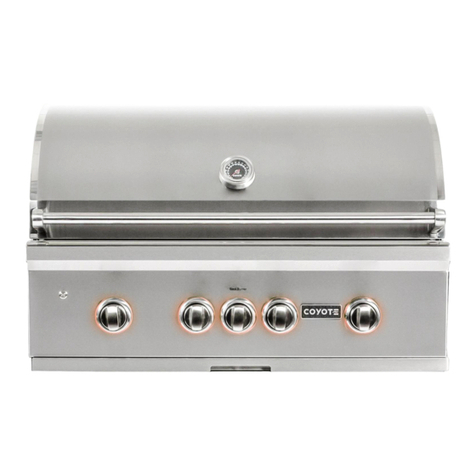
Coyote
Coyote C1SL36 User manual
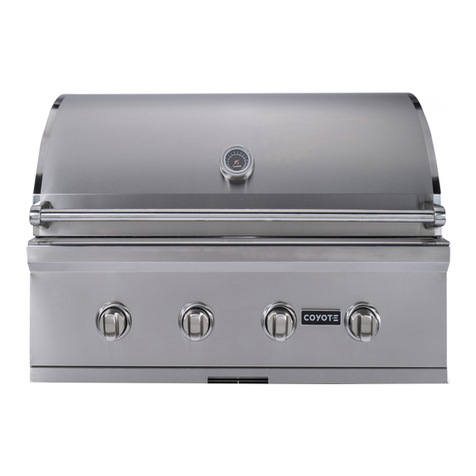
Coyote
Coyote C1C36 User manual

Coyote
Coyote CCX2LP User manual
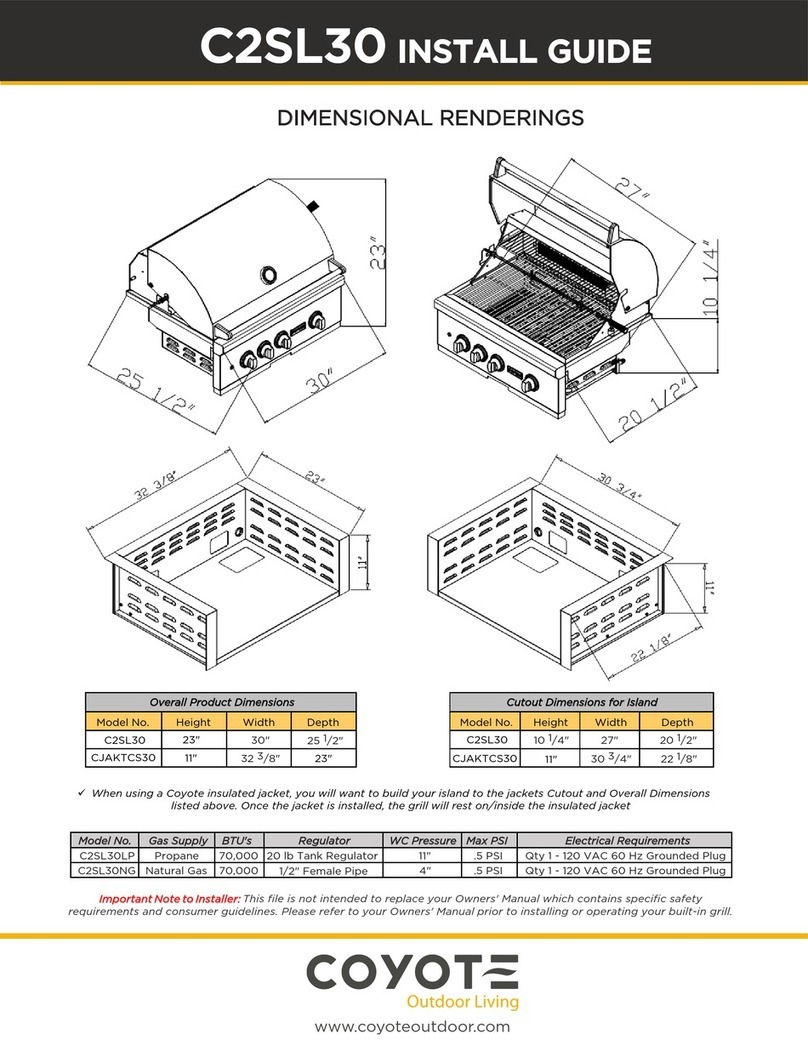
Coyote
Coyote C2SL30 Series User manual
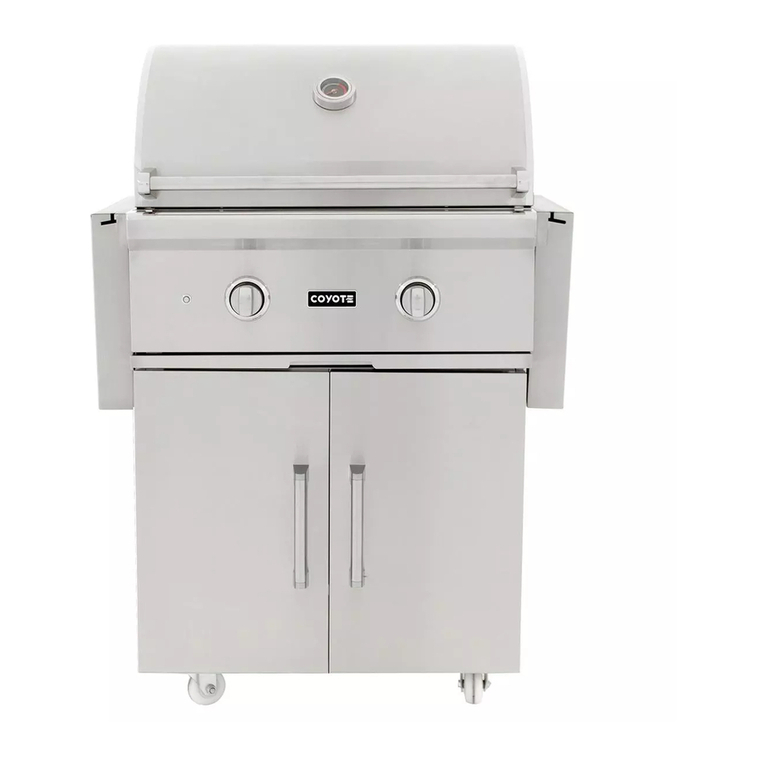
Coyote
Coyote C1C28LP-FS User manual
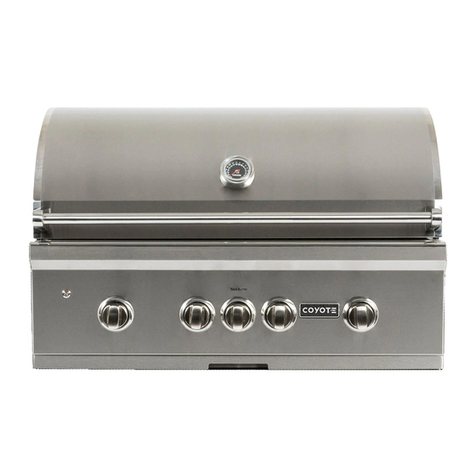
Coyote
Coyote C1S36 User manual
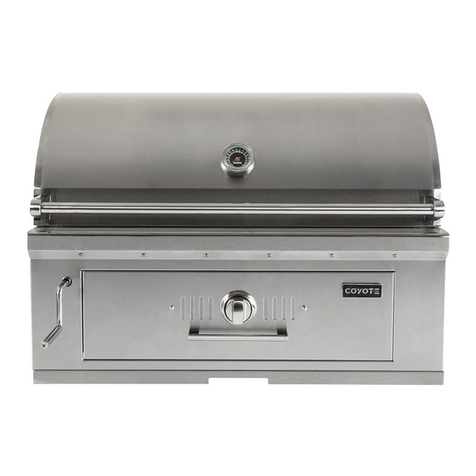
Coyote
Coyote C1CH36 User manual

Coyote
Coyote C Series User manual
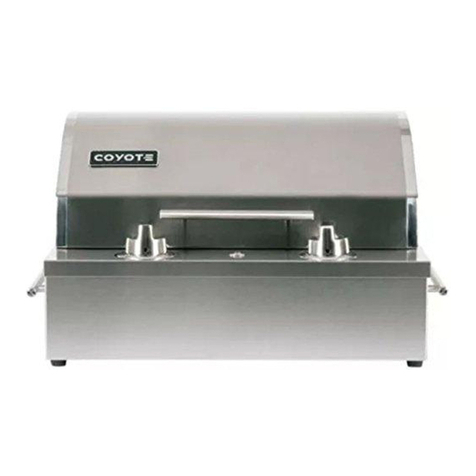
Coyote
Coyote C1ELCT21 User manual
